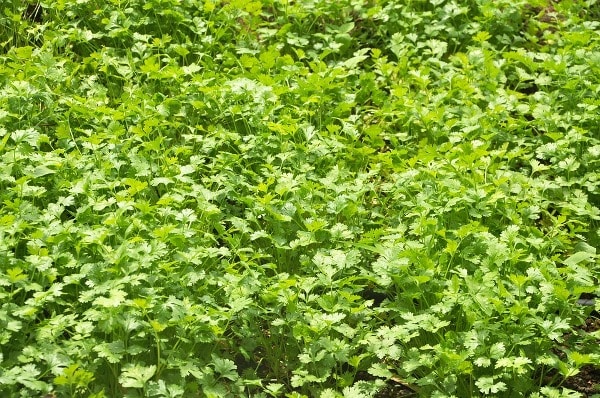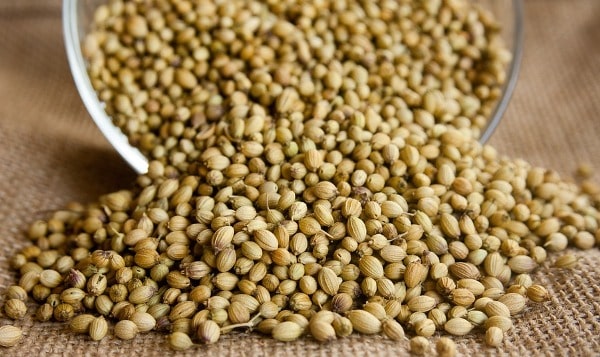How To Grow Coriander on Terrace (from seeds)
Today, we will be discussing how to grow coriander on the terrace (Dhaniya) from seeds. A step-by-step guide for growing Dhaniya on the terrace.
Coriander, which is scientifically called Coriandrum sativum is also termed cilantro. This is a herb that has dark green leaves. The harvest of these leaves should be done when they are fresh for using them as a flavor in many of the Asian and Latin recipes. This is also popularly known as Chinese Parsley. This is not that difficult to grow and the plantation of seeds can be done directly in the soil as soon as the frost passes away. The coriander can also be grown in pots.

Growing Coriander (Dhaniya) on the Terrace:
- To grow coriander on a terrace, you need to first select a container or a pot that has a width of 20 inches and a depth of 10 inches. The pot in which coriander is planted should be sufficiently big so that it can hold the plant which is grown completely.
- Now start filling the pot with soil that drains fast. You can also mix some fertilizer if you wish to. Some amount of water should be added to the soil in order to make it moist. The soil should be damp and make sure that you are not making it soggy. The seeds must be sprinkled on the soil lightly to make them disperse in an even manner. Cover the seeds with another 0.8 cms of soil.
- Coriander will need complete sun for the purpose of growing. To ensure that it is placed in a window sill or a conservatory. The windows which face to the south will allow most of the light and also provide coriander with the best conditions for growing. The germination of seeds of coriander will take place in a week or ten days.
- The soil must be kept in a moist condition by making use of a spray bottle to slightly making the soil moist. If you provide water to the soil directly without using a spray bottle, that will cause the displacement of seeds.
- When the stems of coriander will reach a length of 6 inches, then they can be harvested. You need to remove up to 2/3rds of the leaves every one week so that the plant would be encouraged to grow. In this way, it would be possible to harvest four to five crops of coriander in one pot. In this way, the growth of coriander in a pot takes place.
In case if you miss this: Millets Farming.
Growing Coriander in Garden:

- The best time for the plantation of Coriander in Garden is completely based on the location where you are living in. Coriander cannot survive in the environmental conditions which are frosty. It will not even survive in the environmental conditions which are extremely hot. In the climates which are temperate, late spring will be the best time to start the plantation of Coriander. That is in between March and May months. In extreme tropical climates, Coriander will grow in a better way at the time of dryness in the year, like fall.
- You can also achieve success in the plantation of coriander at the end of the summer and also by making it grow in the fall.
- If the climate becomes very hot, the plants of coriander will start bolting. That means the plants will start flowers and go to the stage of seed. So it is always important to select the time in a wise manner. To get a very good start, you can first start planting your seeds indoors and then move them to your outdoors as per the improvement in weather conditions.
- Now choose a soil patch at which the coriander will be completely exposed to the sun. In Southern regions, the coriander will be able to tolerate some shade mainly in the areas where the sun will be very hot in the daytime. The soil should be drained well and also light. Its pH should be between 6 and 6.8.
- If you want the cultivation of soil to happen before plantation, make use of a shovel or spade to work for a minimum of 3 inches of organic mulch like rotten leaves, compost, or manure in the soil’s top layer. If you are making use of the manure, ensure that the manure is aged for a minimum of three months so that the burning of young plants will not occur. The area should be raked smooth before the plantation takes place.

- The seeds should be sown for above 0.5-inch depth and space should be maintained up to 8 inches. In rows, the space between the seeds should be at least 0.4 centimeters apart. The seeds of coriander will require a lot of moisture for the process of germination to take place. Ensure that the watering is done on a regular basis. They will need almost 0.5 inches of water for one week. The germination of seeds will occur in about 3 weeks.
- As the growth of coriander occurs very quickly, the plantation of a new batch of seeds should be done every three weeks just to make sure that you have a new supply of coriander across the season of growing.
- As soon as the seedling reaches the height of two inches, fertilization can take place with the help of organic fertilizers or compost. Be very careful that you are not over-fertilizing, you will need just 1/4th of a cup for every 28 feet of the space where the coriander is growing.
- As soon as the establishment of plants is done, they will not need much water. Your goal should be to maintain the soil damp. Remember that you are not making it soggy as coriander is a herb that needs a dry climate.
In case if you are Interested in this: Cricket Farming.
- Prevent the plants of coriander from getting overcrowded by implementing thinning on the seedlings when the coriander reaches a height of 3 inches. The coriander plants which are smaller have to be pulled out and the strongest plants have to be left so that they can grow larger. The space between these strong plants should be at least 8 inches. The plants which are smaller can be used for the purpose of cooking and can also be eaten directly.
- Prevention of weeds can be done by spreading a little amount of mulch around the plant base as soon as you see them coming above the surface of the soil.
- The coriander can be harvested by slicing off leaves and stems from the plant base which is near the level of the ground. This can be done when the stems reach a height of at least six inches. You can make use of the new shoots at the time of cooking. For the purpose of cooking, you should not use older and ferny type ones as they will have a bitter taste.
- Make sure that you are not cutting more than 1/3rd of the leaves at a time as this will make the plant weak.
- Once the leaves are harvested, the plant will grow for at least three more cycles continuously.
- After this, the coriander plants will start flowering. When flowering starts, the plant will stop the production of new shoots with leaves that are edible. At this stage, we see few people cutting off the flowers hoping for the coriander plant to produce a number of leaves.
- If you want to harvest the seeds of coriander, then you will have to leave the plant until flowering occurs. Once the flower gets dried, you can harvest the seeds of coriander which can also be used for the purpose of cooking.
- As an alternative, you can also let the seeds fall naturally onto the ground where the plant of coriander will sow on itself, which would again provide you with more plants of coriander in the coming season. The seeds which are dried can be saved and used for plantation in the coming season of growing.
Bottom line: Hope, this how-to grow coriander on the terrace helps you grow your own healthy Coriander.
In case if you are interested in this: Onion Growing Tips, Tricks, and Secretes.
- Goat Farming Training Programs in India: A Beginner’s Guide
- Types of Pesticides Used in Agriculture: A Beginner’s Guide
- Economical Aquaculture: A Guide to Low-Budget Fish Farming
- 15 Common Planting Errors That Can Doom Your Fruit Trees
- How to Make Houseplants Bushy: Effective Tips and Ideas
- Innovative Strategies for Boosting Coconut Pollination and Yield
- Pollination Strategies for Maximum Pumpkin Yield
- The Complete Guide to Chicken Fattening: Strategies for Maximum Growth
- Natural Solutions for Tulip Problems: 100% Effective Remedies for Leaf and Bulb-Related Issues
- Revolutionizing Citrus Preservation: Towards a Healthier, Greener Future
- Natural Solutions for Peony Leaf and Flower Problems: 100% Effective Remedies
- Maximizing Profits with Avocado Contract Farming in India: A Comprehensive Guide
- Natural Solutions for Hydrangea Problems: 100% Effective Remedies for Leaf and Flowers
- The Ultimate Guide to Choosing the Perfect Foliage Friend: Bringing Life Indoors
- From Sunlight to Sustainability: 15 Ways to Use Solar Technology in Agriculture
- The Ultimate Guide to Dong Tao Chicken: Exploring from History to Raising
- The Eco-Friendly Makeover: How to Convert Your Unused Swimming Pool into a Fish Pond
- Mastering the Art of Delaware Chicken Farming: Essentials for Healthy Backyard Flocks
- 20 Best Homemade Fertilizers for Money Plant: DIY Recipes and Application Methods
- How to Craft a Comprehensive Free-Range Chicken Farming Business Plan
- Brighten Your Flock: Raising Easter Egger Chickens for Beauty and Bounty
- How to Optimize Your Poultry Egg Farm Business Plan with These Strategies
- Subsidy for Spirulina Cultivation: How Indian Government Schemes Encouraging Spirulina Farmers
- Ultimate Guide to Raising Dominique Chickens: Breeding, Feeding, Egg-Production, and Care
- Mastering the Art of Raising Jersey Giant Chickens: Care, Feeding, and More
- Ultimate Guide to Raising Legbar Chickens: Breeding, Farming Practices, Diet, Egg-Production
- How to Raise Welsummer Chickens: A Comprehensive Guide for Beginners